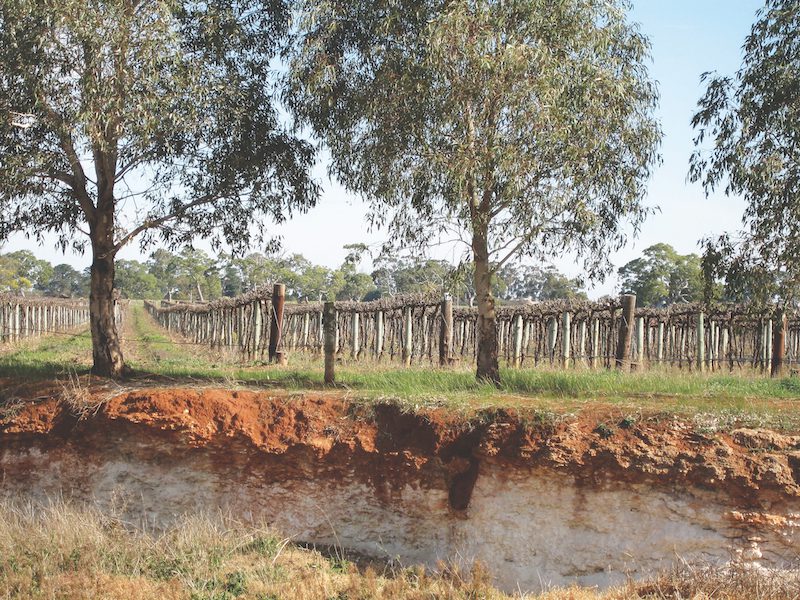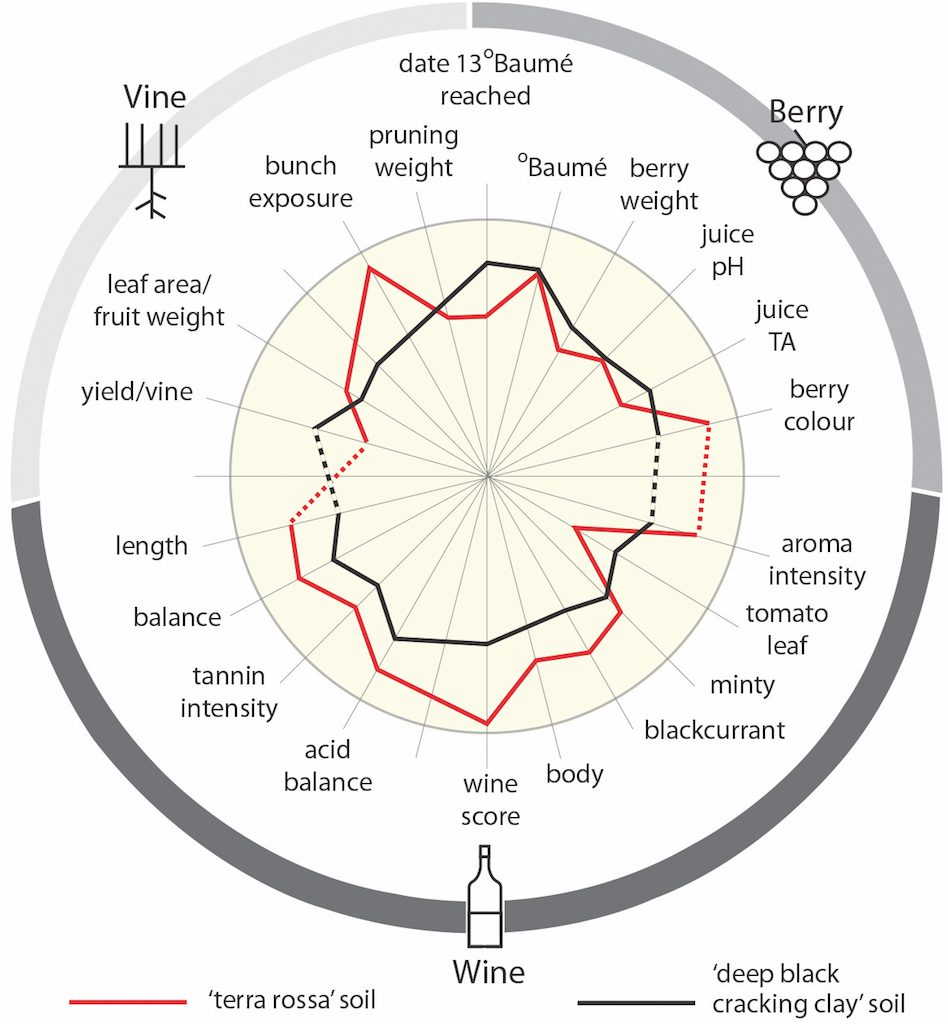
In the new book Australian Wine: styles and tastes, people and places – by Dr Patrick Iland OAM, Peter Gago AC, Andrew Caillard MW and Peter Dry – several stories explore why the taste of a wine differs to that of another wine.
At any one region/subregion/site several factors — climate, soil properties and management practices — all combine to shape the taste of a wine. In some cases one element will play a larger role than others — some examples are given below.
Why Barossa Valley Shiraz differs from Eden Valley Shiraz
This is part of the ‘Barossa Grounds’ study. Barossa Grounds is a landmark project organised by the Barossa Grape & Wine Association. It was established to evaluate the variations of wine style from different locations (grounds) across the Barossa Zone.
Soil scientists, researchers from South Australia’s leading research institutions, wine critics and many of Barossa’s most experienced winemakers, growers and viticulturists participated. Over many years the project mapped the region’s climatic elements, excavated soil pits and identified soil types.
Each vintage, winemakers sourced grapes from the same single vineyards around the Barossa Zone and made wine under controlled winemaking conditions. Annual tasting reviews and discussions followed resulting in a growing body of scientific analyses and interpretation. The Barossa Grounds project represents years of research and generational experience. It offers observers and wine consumers a valuable insight about the unique terroirs and character of Barossa wine. It focuses on regional differences — between the Barossa Valley and Eden Valley and subregional differences — between different subregions of the Barossa Valley.
Here we tell the story of the difference between Shiraz wines from the Barossa Valley and Eden Valley…
Eden Valley
Altitude 217 – 630 metres
99% of the area is >280 metres
Cool, moderately maritime, sunny, moderately humid, arid
Barossa Valley
Altitude 112 – 597 metres
53% of the area is <280 metres
Warm, moderately continental, very sunny, moderately humid, arid
The higher altitude of the Eden Valley region results in wetter and cooler weather than in the Barossa Valley. Day time temperatures in the Eden Valley can be 2-3°C lower and night time temperatures 5-7°C lower than those of the Barossa Valley. The mean January temperature (MJT) of the Eden Valley region ranges from about 19.5 to 21.0°C, while the Barossa Valley region ranges from about 21.0 to 23.1°C. A ‘growing degree days’ map below shows these temperature differences. A Mean January temperature (MJT) map would show a similar pattern.
Compared with the Eden Valley, the warmer conditions of the Barossa Valley build weight and fruit richness in Barossa Valley Shiraz. On the other hand, the cooler conditions of Eden Valley build aromatic notes and drive the flavour shape of these wines towards more elegant, tightly structured, linear styles.
Comparing Barossa Valley Shiraz with Eden Valley Shiraz, the Barossa Valley style is typically more full-bodied, richly flavoured, voluptuous and softer, with some spice and red and dark fruit aromas, but more towards black cherry, mulberry, plum, chocolate and earthy aromas, while the Shiraz wines from Eden Valley tend to be more elegant, vibrant, aromatic, medium- to full-bodied styles, also richly flavoured with red and black fruits, but with the aroma spectrum more towards spice and red and dark cherry, blueberry, blackberry, plums and licorice.
The spice of wines from the Barossa Valley is more of a cinnamon nature while that of wines from Eden Valley is white and black pepper. The mouthfeel of Barossa Valley Shiraz is silky to velvety with expressive, but soft, puckering tannins. Eden Valley Shiraz can also be silky and velvety, but with a more dusty, drying nature to the tannins. The natural acidity is higher in the Eden Valley wines and this, and the nature of the tannins, give them a tighter structure than experienced in the Barossa Valley wines.
The soils of the Barossa Valley are somewhat diverse due to the complex geology of the region. They range from deep sandy loams to clay loams and red brown earths, while those of Eden Valley are mainly shallow rocky soils.
Even though there are differences in the soils across each region and between the two regions, it is highly likely that the difference in the taste of most Barossa Valley and most Eden Valley Shiraz is largely due to temperature differences between the two regions.
Why Frankland Estate Isolation Ridge Riesling differs to their Poison Hill Riesling
Frankland Estate, in the Frankland River subregion of the Great Southern region of Western Australia, makes two single vineyard Riesling wines — Isolation Ridge and Poison Hill. Even though the wines are from the same subregion there are key differences in their sensory expression.
Hunter Smith, of Frankland Estate, explains the sensory differences — Isolation Ridge Riesling is typically citrus, lemon-focused and round in style with distinct chalkiness. Poison Hill Riesling is more floral in character with lavender, lime notes and soft talc-like textures. Both are naturally high in acidity.
The Isolation Ridge and Poison Hill vineyards are in the same subregion, yet the differences in terroir are quite stark. The temperatures at Isolation Ridge, which often has a band of cloud hovering over it, are cooler than those of Poison Hill. The soils at Isolation Ridge site are lateric, with conglomerate ironstone over a loam into ancient clays. The ‘unique’ Poison Hill vineyard site is white-weathered granite with a high silica content. Hunter Smith says “All of these differences, particularly the soil profiles, play a big role in shaping the terroir of each vineyard.”

An example of a ’vine to wine’ web showing vine, berry and wine characteristics from the terra rossa and deep black cracking clay soils.
Dr Tony Proffitt, when he worked as a viticulturist with Wynns, conducted a study with Cabernet Sauvignon to investigate the differences in soil characteristics, berry composition and wine style from an area where the two soil types were located close together.
Wines were made from fruit sourced from vines grown on each soil type. The black soil has a heavier (more clay) topsoil and subsoil texture, a deeper and more extensive root system, often pushing down into softer limestone and a greater water holding capacity. Vines on the black soil have more vigorous and longer shoots, denser canopies and higher yields than vines grown on the terra rossa soil. Berries from the vines on terra rossa soil are smaller and more intensely coloured than those from the black soil. Wines from vines on the terra rossa soil have a more intense aroma — stronger blackcurrant character — and are more full-bodied, concentrated and complex than wines from vines grown on the black soil.
The study demonstrates how a change in terroir over a very short distance can impact on vine growth and berry and wine composition and sensory characters. Note, the degree of difference will vary from year to year.
Analysis of the soils showed that the major difference between the red and black soils is the amount of water available to the vine roots — approximately 50% more for the black soil than the terra rossa.
To order a copy of Australian Wine: styles and tastes, people and places click here
“Could this be the most comprehensive book to all things Australian wine ever written? A remarkable detailed resource and highly recommended.” – Tyson Stelzer













Recent Comments